Bozhko Victoria Gr. 32 TheUniversity of
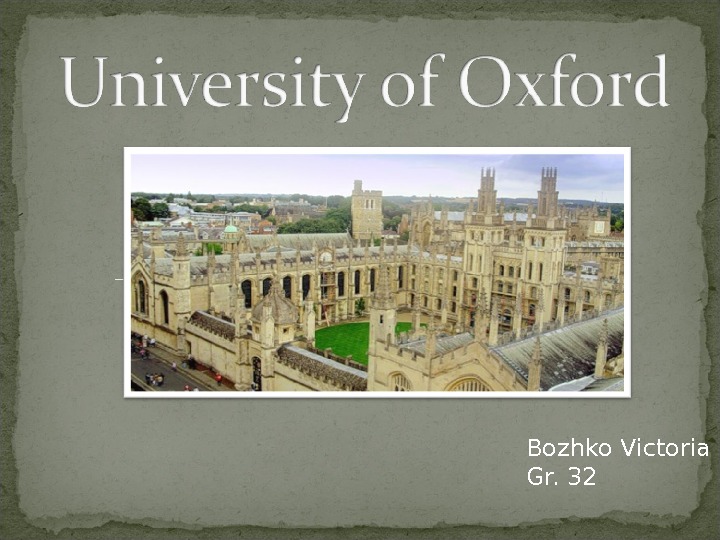
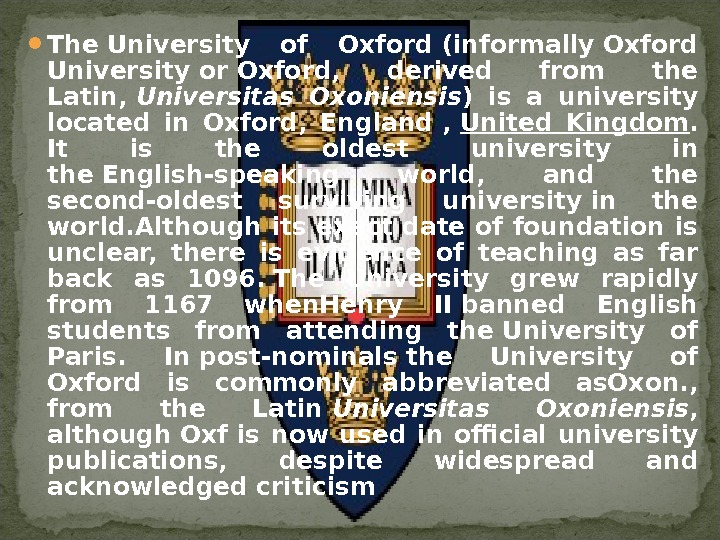
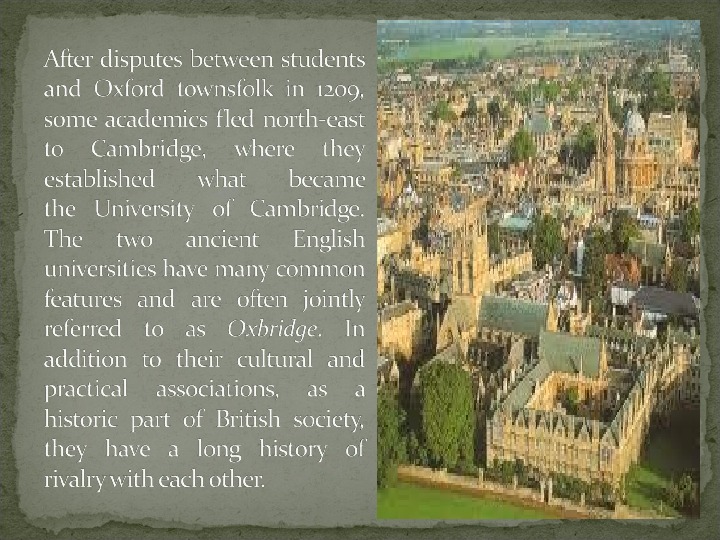
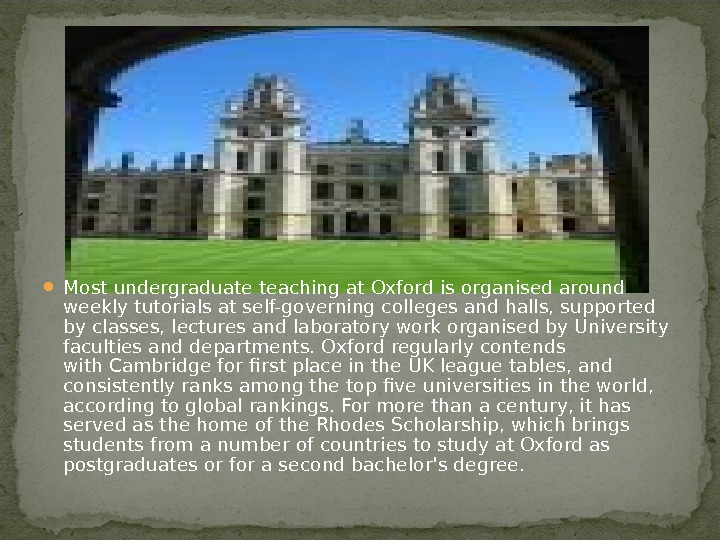
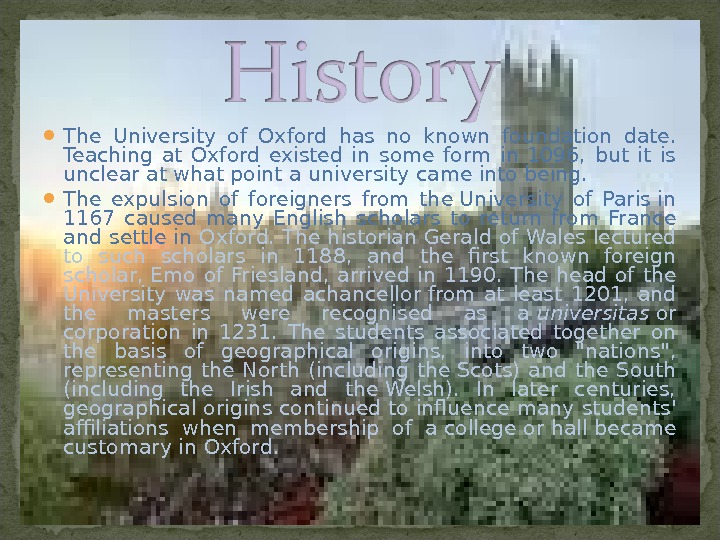
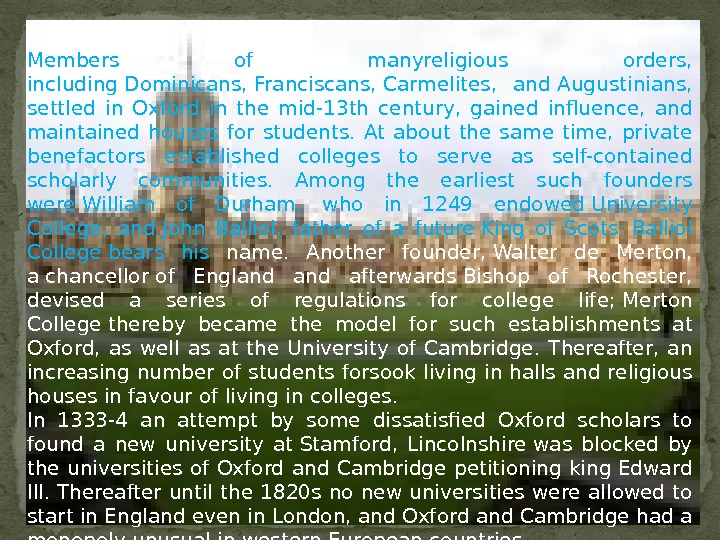

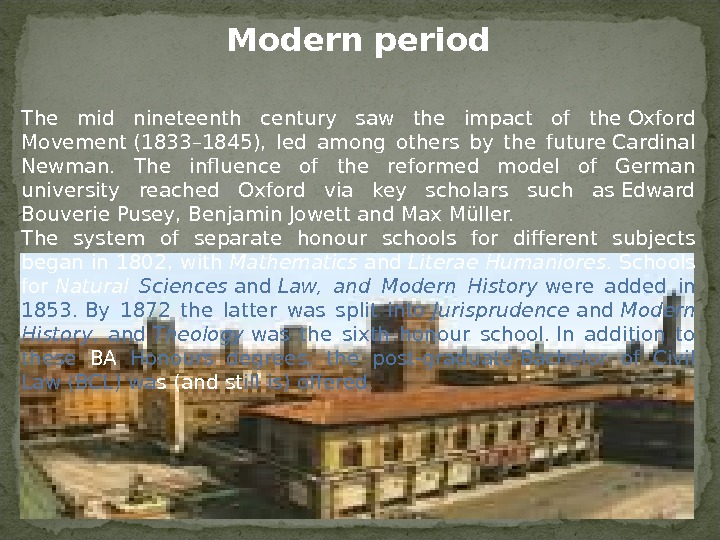
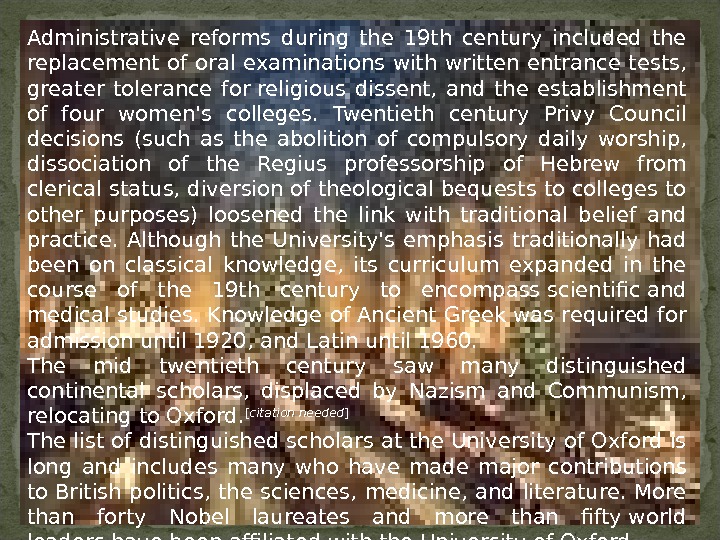
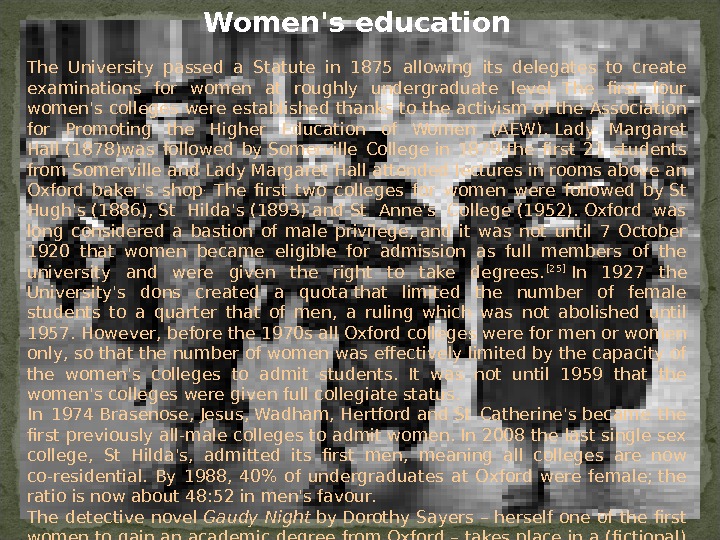
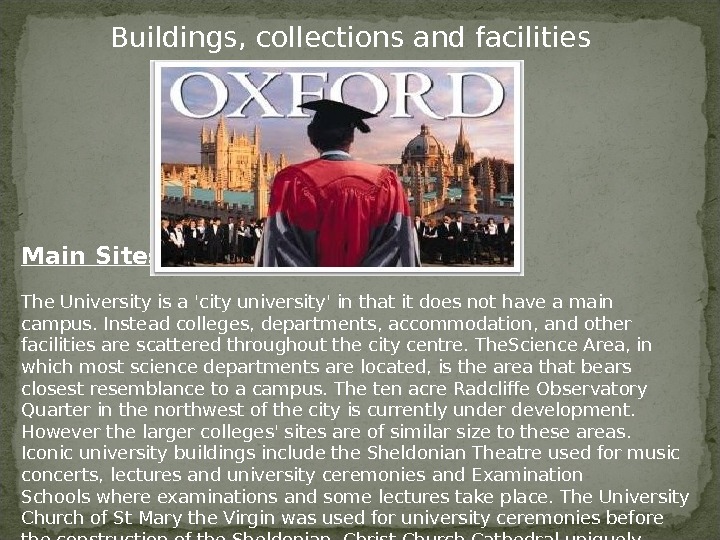
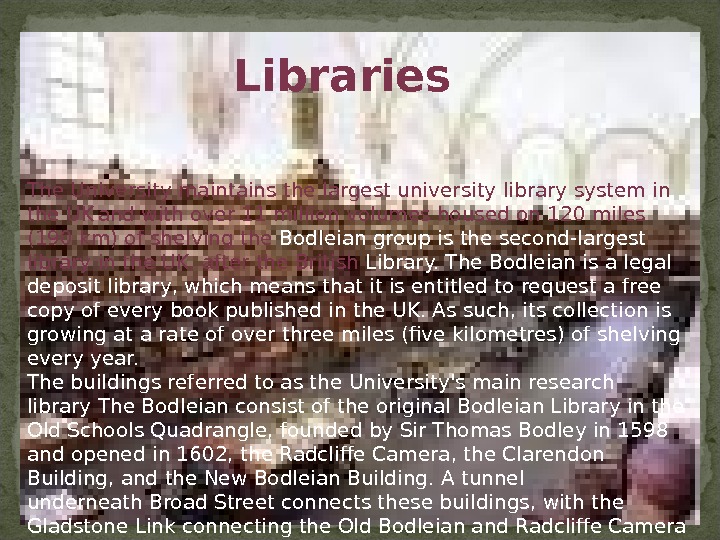
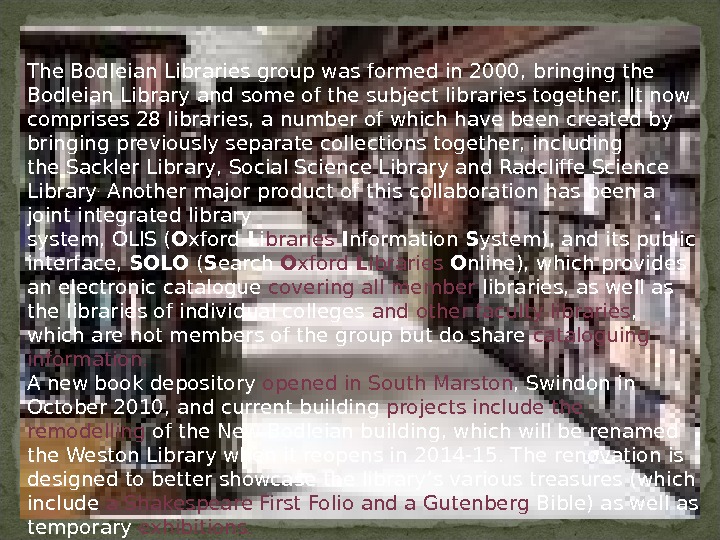
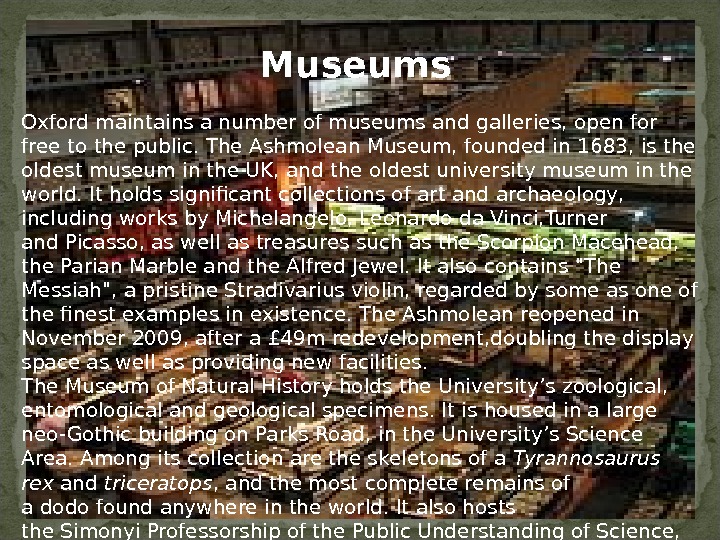
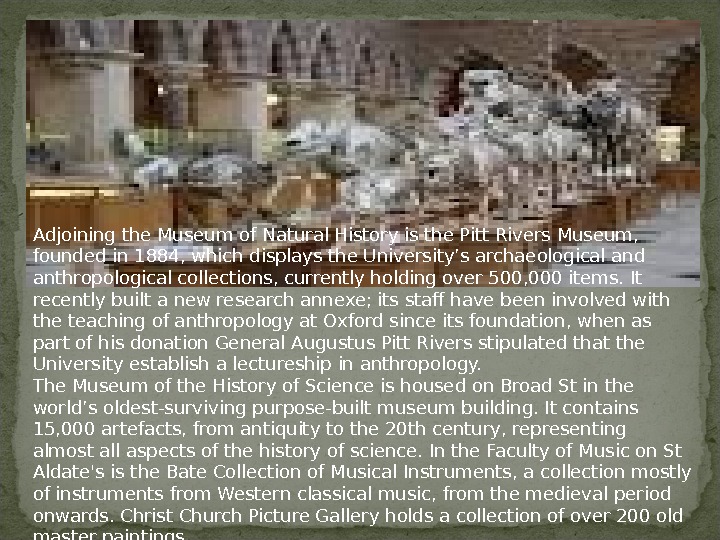
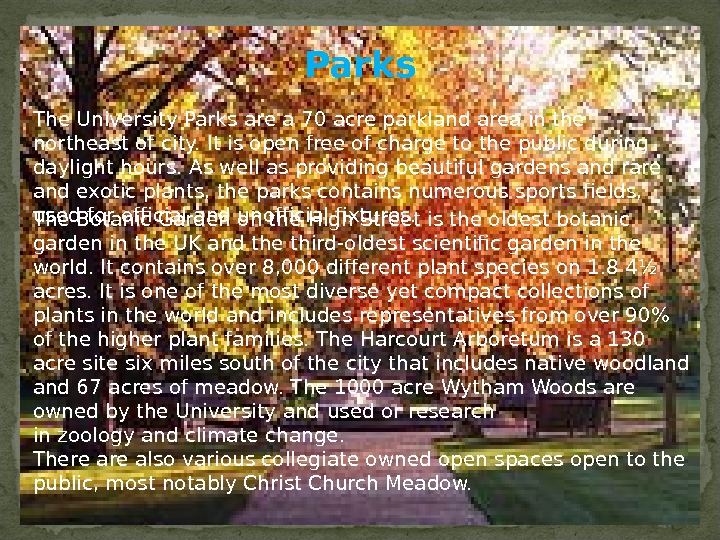
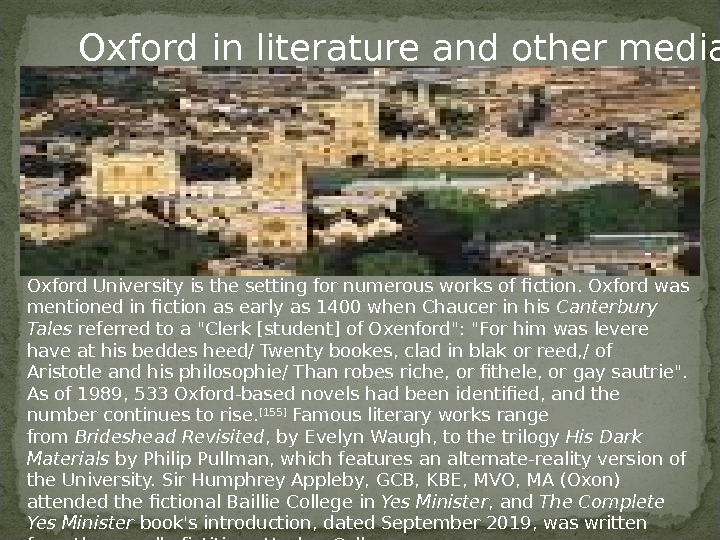

- Размер: 3.4 Mегабайта
- Количество слайдов: 18
Описание презентации Bozhko Victoria Gr. 32 TheUniversity of по слайдам
 Bozhko Victoria Gr.
Bozhko Victoria Gr.
 The. University of Oxford(informally. Oxford Universityor. Oxford, derived from the Latin, Universitas Oxoniensis ) is a university located in Oxford, England, United Kingdom. It is the oldest university in the. English-speaking world, and the second-oldest surviving universityin the world. Although its exact date of foundation is unclear, there is evidence of teaching as far back as 1096. The University grew rapidly from 1167 when. Henry IIbanned English students from attending the. University of Paris. Inpost-nominalsthe University of Oxford is commonly abbreviated as. Oxon. , from the Latin Universitas Oxoniensis , although. Oxfis now used in official university publications, despite widespread and acknowledged criticism
The. University of Oxford(informally. Oxford Universityor. Oxford, derived from the Latin, Universitas Oxoniensis ) is a university located in Oxford, England, United Kingdom. It is the oldest university in the. English-speaking world, and the second-oldest surviving universityin the world. Although its exact date of foundation is unclear, there is evidence of teaching as far back as 1096. The University grew rapidly from 1167 when. Henry IIbanned English students from attending the. University of Paris. Inpost-nominalsthe University of Oxford is commonly abbreviated as. Oxon. , from the Latin Universitas Oxoniensis , although. Oxfis now used in official university publications, despite widespread and acknowledged criticism

 Most undergraduate teaching at Oxford is organised around weeklytutorialsat self-governing colleges and halls, supported by classes, lectures and laboratory work organised by University faculties and departments. Oxford regularly contends with. Cambridgefor first place in the. UK league tables, and consistentlyranksamong the top five universities in the world, according to global rankings. For more than a century, it has served as the home of the. Rhodes Scholarship, which brings students from a number of countries to study at Oxford as postgraduates or for a second bachelor’s degree.
Most undergraduate teaching at Oxford is organised around weeklytutorialsat self-governing colleges and halls, supported by classes, lectures and laboratory work organised by University faculties and departments. Oxford regularly contends with. Cambridgefor first place in the. UK league tables, and consistentlyranksamong the top five universities in the world, according to global rankings. For more than a century, it has served as the home of the. Rhodes Scholarship, which brings students from a number of countries to study at Oxford as postgraduates or for a second bachelor’s degree.
 The University of Oxford has no known foundation date. Teaching at Oxford existed in some form in 1096, but it is unclear at what point a university came into being. The expulsion of foreigners from the. University of Parisin 1167 caused many English scholars to return from France and settle in Oxford. The historian. Gerald of Waleslectured to such scholars in 1188, and the first known foreign scholar, Emo of Friesland, arrived in 1190. The head of the University was named achancellorfrom at least 1201, and the masters were recognised as a universitas or corporation in 1231. The students associated together on the basis of geographical origins, into two «nations», representing the North (including the. Scots) and the South (including the Irish and the. Welsh). In later centuries, geographical origins continued to influence many students’ affiliations when membership of acollegeorhallbecame customary in Oxford.
The University of Oxford has no known foundation date. Teaching at Oxford existed in some form in 1096, but it is unclear at what point a university came into being. The expulsion of foreigners from the. University of Parisin 1167 caused many English scholars to return from France and settle in Oxford. The historian. Gerald of Waleslectured to such scholars in 1188, and the first known foreign scholar, Emo of Friesland, arrived in 1190. The head of the University was named achancellorfrom at least 1201, and the masters were recognised as a universitas or corporation in 1231. The students associated together on the basis of geographical origins, into two «nations», representing the North (including the. Scots) and the South (including the Irish and the. Welsh). In later centuries, geographical origins continued to influence many students’ affiliations when membership of acollegeorhallbecame customary in Oxford.
 Members of manyreligious orders, including. Dominicans, Franciscans, Carmelites, and. Augustinians, settled in Oxford in the mid-13 th century, gained influence, and maintained houses for students. At about the same time, private benefactors established colleges to serve as self-contained scholarly communities. Among the earliest such founders were. William of Durham, who in 1249 endowed. University College, and. John Balliol, father of a future. King of Scots: Balliol Collegebears his name. Another founder, Walter de Merton, achancellorof England afterwards. Bishop of Rochester, devised a series of regulations for college life; Merton Collegethereby became the model for such establishments at Oxford, as well as at the University of Cambridge. Thereafter, an increasing number of students forsook living in halls and religious houses in favour of living in colleges. In 1333 -4 an attempt by some dissatisfied Oxford scholars to found a new university at. Stamford, Lincolnshirewas blocked by the universities of Oxford and Cambridge petitioning king. Edward III. Thereafter until the 1820 s no new universities were allowed to start in England even in London, and Oxford and Cambridge had a monopoly unusual in western European countries.
Members of manyreligious orders, including. Dominicans, Franciscans, Carmelites, and. Augustinians, settled in Oxford in the mid-13 th century, gained influence, and maintained houses for students. At about the same time, private benefactors established colleges to serve as self-contained scholarly communities. Among the earliest such founders were. William of Durham, who in 1249 endowed. University College, and. John Balliol, father of a future. King of Scots: Balliol Collegebears his name. Another founder, Walter de Merton, achancellorof England afterwards. Bishop of Rochester, devised a series of regulations for college life; Merton Collegethereby became the model for such establishments at Oxford, as well as at the University of Cambridge. Thereafter, an increasing number of students forsook living in halls and religious houses in favour of living in colleges. In 1333 -4 an attempt by some dissatisfied Oxford scholars to found a new university at. Stamford, Lincolnshirewas blocked by the universities of Oxford and Cambridge petitioning king. Edward III. Thereafter until the 1820 s no new universities were allowed to start in England even in London, and Oxford and Cambridge had a monopoly unusual in western European countries.
 Renaissance period The new learning of the. Renaissancegreatly influenced Oxford from the late 15 th century onwards. Among university scholars of the period were. William Grocyn, who contributed to the revival of. Greek languagestudies, and. John Colet, the notedbiblical scholar. With the. Reformationand the breaking of ties with the Roman Catholic Church, Recusantscholars from Oxford fled to continental Europe, settling especially at the. University of Douai. The method of teaching at Oxford was transformed from the medieval. Scholastic methodto Renaissance education, although institutions associated with the university suffered losses of land revenues. In 1636, Chancellor. William Laud, archbishop of Canterbury, codified the university’s statutes; these to a large extent remained its governing regulations until the mid-19 th century. Laud was also responsible for the granting of a charter securing privileges for the. University Press, and he made significant contributions to the. Bodleian Library, the main library of the university. From the inception of the. Church of Englanduntil 1866 membership of the church was a requirement to receive the BA degree from Oxford, and «dissenters» were only permitted to receive the MA in 1871. The university was a centre of the. Royalistparty during the. English Civil War(1642– 1649), while the town favoured the opposing. Parliamentariancause. From the mid-18 th century onwards, however, the University of Oxford took little part in political conflicts. Renaissance period
Renaissance period The new learning of the. Renaissancegreatly influenced Oxford from the late 15 th century onwards. Among university scholars of the period were. William Grocyn, who contributed to the revival of. Greek languagestudies, and. John Colet, the notedbiblical scholar. With the. Reformationand the breaking of ties with the Roman Catholic Church, Recusantscholars from Oxford fled to continental Europe, settling especially at the. University of Douai. The method of teaching at Oxford was transformed from the medieval. Scholastic methodto Renaissance education, although institutions associated with the university suffered losses of land revenues. In 1636, Chancellor. William Laud, archbishop of Canterbury, codified the university’s statutes; these to a large extent remained its governing regulations until the mid-19 th century. Laud was also responsible for the granting of a charter securing privileges for the. University Press, and he made significant contributions to the. Bodleian Library, the main library of the university. From the inception of the. Church of Englanduntil 1866 membership of the church was a requirement to receive the BA degree from Oxford, and «dissenters» were only permitted to receive the MA in 1871. The university was a centre of the. Royalistparty during the. English Civil War(1642– 1649), while the town favoured the opposing. Parliamentariancause. From the mid-18 th century onwards, however, the University of Oxford took little part in political conflicts. Renaissance period
 Modern period The mid nineteenth century saw the impact of the. Oxford Movement(1833– 1845), led among others by the future. Cardinal Newman. The influence of the reformed model of German university reached Oxford via key scholars such as. Edward Bouverie Pusey, Benjamin Jowettand. Max Müller. The system of separate honour schools for different subjects began in 1802, with Mathematics and Literae Humaniores. Schools for Natural Sciences and Law, and Modern History were added in 1853. By 1872 the latter was split into Jurisprudence and Modern History , and Theology was the sixth honour school. In addition to these BA Honours degrees, the post-graduate. Bachelor of Civil Law (BCL)wa s (and st ill is) offered.
Modern period The mid nineteenth century saw the impact of the. Oxford Movement(1833– 1845), led among others by the future. Cardinal Newman. The influence of the reformed model of German university reached Oxford via key scholars such as. Edward Bouverie Pusey, Benjamin Jowettand. Max Müller. The system of separate honour schools for different subjects began in 1802, with Mathematics and Literae Humaniores. Schools for Natural Sciences and Law, and Modern History were added in 1853. By 1872 the latter was split into Jurisprudence and Modern History , and Theology was the sixth honour school. In addition to these BA Honours degrees, the post-graduate. Bachelor of Civil Law (BCL)wa s (and st ill is) offered.
 Administrative reforms during the 19 th century included the replacement of oral examinations with written entrance tests, greater tolerance forreligious dissent, and the establishment of four women’s colleges. Twentieth century Privy Council decisions (such as the abolition of compulsory daily worship, dissociation of the Regius professorship of Hebrew from clerical status, diversion of theological bequests to colleges to other purposes) loosened the link with traditional belief and practice. Although the University’s emphasis traditionally had been on classical knowledge, its curriculum expanded in the course of the 19 th century to encompassscientificand medical studies. Knowledge of. Ancient Greekwas required for admission until 1920, and Latin until 1960. The mid twentieth century saw many distinguished continental scholars, displaced by Nazism and Communism, relocating to Oxford. [ citation needed ] The list of distinguished scholars at the University of Oxford is long and includes many who have made major contributions to. British politics, the sciences, medicine, and literature. More than forty Nobel laureates and more than fiftyworld leadershave been affiliated with the University of Oxford.
Administrative reforms during the 19 th century included the replacement of oral examinations with written entrance tests, greater tolerance forreligious dissent, and the establishment of four women’s colleges. Twentieth century Privy Council decisions (such as the abolition of compulsory daily worship, dissociation of the Regius professorship of Hebrew from clerical status, diversion of theological bequests to colleges to other purposes) loosened the link with traditional belief and practice. Although the University’s emphasis traditionally had been on classical knowledge, its curriculum expanded in the course of the 19 th century to encompassscientificand medical studies. Knowledge of. Ancient Greekwas required for admission until 1920, and Latin until 1960. The mid twentieth century saw many distinguished continental scholars, displaced by Nazism and Communism, relocating to Oxford. [ citation needed ] The list of distinguished scholars at the University of Oxford is long and includes many who have made major contributions to. British politics, the sciences, medicine, and literature. More than forty Nobel laureates and more than fiftyworld leadershave been affiliated with the University of Oxford.
 Women’s education The University passed a Statute in 1875 allowing its delegates to create examinations for women at roughly undergraduate level. The first four women’s colleges were established thanks to the activism of the Association for Promoting the Higher Education of Women (AEW). Lady Margaret Hall(1878)was followed by. Somerville Collegein 1879; the first 21 students from Somerville and Lady Margaret Hall attended lectures in rooms above an Oxford baker’s shop. The first two colleges for women were followed by. St Hugh’s(1886), St Hilda’s(1893)and. St Anne’s College(1952). Oxford was long considered a bastion of male privilege, and it was not until 7 October 1920 that women became eligible for admission as full members of the university and were given the right to take degrees. [25] In 1927 the University’s dons created a quotathat limited the number of female students to a quarter that of men, a ruling which was not abolished until 1957. However, before the 1970 s all Oxford colleges were for men or women only, so that the number of women was effectively limited by the capacity of the women’s colleges to admit students. It was not until 1959 that the women’s colleges were given full collegiate status. In 1974 Brasenose, Jesus, Wadham, Hertfordand. St Catherine’sbecame the first previously all-male colleges to admit women. In 2008 the last single sex college, St Hilda’s, admitted its first men, meaning all colleges are now co-residential. By 1988, 40% of undergraduates at Oxford were female; the ratio is now about 48: 52 in men’s favour. The detective novel Gaudy Night by. Dorothy Sayers– herself one of the first women to gain an academic degree from Oxford – takes place in a (fictional) women’s college at Oxford, and the issue of women’s education is central to its plot.
Women’s education The University passed a Statute in 1875 allowing its delegates to create examinations for women at roughly undergraduate level. The first four women’s colleges were established thanks to the activism of the Association for Promoting the Higher Education of Women (AEW). Lady Margaret Hall(1878)was followed by. Somerville Collegein 1879; the first 21 students from Somerville and Lady Margaret Hall attended lectures in rooms above an Oxford baker’s shop. The first two colleges for women were followed by. St Hugh’s(1886), St Hilda’s(1893)and. St Anne’s College(1952). Oxford was long considered a bastion of male privilege, and it was not until 7 October 1920 that women became eligible for admission as full members of the university and were given the right to take degrees. [25] In 1927 the University’s dons created a quotathat limited the number of female students to a quarter that of men, a ruling which was not abolished until 1957. However, before the 1970 s all Oxford colleges were for men or women only, so that the number of women was effectively limited by the capacity of the women’s colleges to admit students. It was not until 1959 that the women’s colleges were given full collegiate status. In 1974 Brasenose, Jesus, Wadham, Hertfordand. St Catherine’sbecame the first previously all-male colleges to admit women. In 2008 the last single sex college, St Hilda’s, admitted its first men, meaning all colleges are now co-residential. By 1988, 40% of undergraduates at Oxford were female; the ratio is now about 48: 52 in men’s favour. The detective novel Gaudy Night by. Dorothy Sayers– herself one of the first women to gain an academic degree from Oxford – takes place in a (fictional) women’s college at Oxford, and the issue of women’s education is central to its plot.
 Buildings, collections and facilities Main Sites The University is a ‘city university’ in that it does not have a main campus. Instead colleges, departments, accommodation, and other facilities are scattered throughout the city centre. The. Science Area, in which most science departments are located, is the area that bears closest resemblance to a campus. The ten acre. Radcliffe Observatory Quarterin the northwest of the city is currently under development. However the larger colleges’ sites are of similar size to these areas. Iconic university buildings include the. Sheldonian Theatreused for music concerts, lectures and university ceremonies and. Examination Schoolswhere examinations and some lectures take place. The. University Church of St Mary the Virginwas used for university ceremonies before the construction of the Sheldonian. Christ Church Cathedraluniquely serves as both a college chapel and as a cathedral.
Buildings, collections and facilities Main Sites The University is a ‘city university’ in that it does not have a main campus. Instead colleges, departments, accommodation, and other facilities are scattered throughout the city centre. The. Science Area, in which most science departments are located, is the area that bears closest resemblance to a campus. The ten acre. Radcliffe Observatory Quarterin the northwest of the city is currently under development. However the larger colleges’ sites are of similar size to these areas. Iconic university buildings include the. Sheldonian Theatreused for music concerts, lectures and university ceremonies and. Examination Schoolswhere examinations and some lectures take place. The. University Church of St Mary the Virginwas used for university ceremonies before the construction of the Sheldonian. Christ Church Cathedraluniquely serves as both a college chapel and as a cathedral.
 The University maintains the largest university library system in the UK and with over 11 million volumes housed on 120 miles (190 km) of shelving the Bodleian group is the second-largest library in the UK, after the. British Library. The Bodleian is alegal depositlibrary, which means that it is entitled to request a free copy of every book published in the UK. As such, its collection is growing at a rate of over three miles (five kilometres) of shelving every year. The buildings referred to as the University’s main research library. The Bodleianconsist of the original Bodleian Library in the Old Schools Quadrangle, founded by. Sir Thomas Bodleyin 1598 and opened in 1602, the. Radcliffe Camera, the. Clarendon Building, and the New Bodleian Building. A tunnel underneath. Broad Streetconnects these buildings, with the Gladstone Link connecting the Old Bodleian and Radcliffe Camera opening to readers in 2011. Libraries
The University maintains the largest university library system in the UK and with over 11 million volumes housed on 120 miles (190 km) of shelving the Bodleian group is the second-largest library in the UK, after the. British Library. The Bodleian is alegal depositlibrary, which means that it is entitled to request a free copy of every book published in the UK. As such, its collection is growing at a rate of over three miles (five kilometres) of shelving every year. The buildings referred to as the University’s main research library. The Bodleianconsist of the original Bodleian Library in the Old Schools Quadrangle, founded by. Sir Thomas Bodleyin 1598 and opened in 1602, the. Radcliffe Camera, the. Clarendon Building, and the New Bodleian Building. A tunnel underneath. Broad Streetconnects these buildings, with the Gladstone Link connecting the Old Bodleian and Radcliffe Camera opening to readers in 2011. Libraries
 The. Bodleian Librariesgroup was formed in 2000, bringing the Bodleian Library and some of the subject libraries together. It now comprises 28 libraries, a number of which have been created by bringing previously separate collections together, including the. Sackler Library, Social Science Libraryand. Radcliffe Science Library. Another major product of this collaboration has been a joint integrated library system, OLIS( O xford L i braries I nformation S ystem), and its public interface, SOLO ( S earch O xford L ibraries O nline), which provides an electronic catalogue covering all member libraries, as well as the libraries of individual colleges and other faculty libraries , which are not members of the group but do share cataloguing information. A new book depository opened in. South Marston , Swindonin October 2010, and current building projects include the remodelling of the New Bodleian building, which will be renamed the Weston Library when it reopens in 2014 -15. The renovation is designed to better showcase the library’s various treasures (which include a Shakespeare. First Folioand a. Gutenberg Bible) as well as temporary exhibitions. The Bodleian engaged in a mass-digitisation project with. Googlein
The. Bodleian Librariesgroup was formed in 2000, bringing the Bodleian Library and some of the subject libraries together. It now comprises 28 libraries, a number of which have been created by bringing previously separate collections together, including the. Sackler Library, Social Science Libraryand. Radcliffe Science Library. Another major product of this collaboration has been a joint integrated library system, OLIS( O xford L i braries I nformation S ystem), and its public interface, SOLO ( S earch O xford L ibraries O nline), which provides an electronic catalogue covering all member libraries, as well as the libraries of individual colleges and other faculty libraries , which are not members of the group but do share cataloguing information. A new book depository opened in. South Marston , Swindonin October 2010, and current building projects include the remodelling of the New Bodleian building, which will be renamed the Weston Library when it reopens in 2014 -15. The renovation is designed to better showcase the library’s various treasures (which include a Shakespeare. First Folioand a. Gutenberg Bible) as well as temporary exhibitions. The Bodleian engaged in a mass-digitisation project with. Googlein
 Oxford maintains a number of museums and galleries, open for free to the public. The. Ashmolean Museum, founded in 1683, is the oldest museum in the UK, and the oldest university museum in the world. It holds significant collections of art and archaeology, including works by. Michelangelo, Leonardo da Vinci, Turner and. Picasso, as well as treasures such as the. Scorpion Macehead, the. Parian Marbleand the. Alfred Jewel. It also contains «The Messiah», a pristine Stradivarius violin, regarded by some as one of the finest examples in existence. The Ashmolean reopened in November 2009, after a £ 49 m redevelopment, doubling the display space as well as providing new facilities. The. Museum of Natural Historyholds the University’s zoological, entomological and geological specimens. It is housed in a large neo-Gothic building on. Parks Road, in the University’s. Science Area. Among its collection are the skeletons of a Tyrannosaurus rex and triceratops , and the most complete remains of adodofound anywhere in the world. It also hosts the. Simonyi. Professorship of the Public Understanding of Science, currently held by. Marcus du Sautoy. Museums
Oxford maintains a number of museums and galleries, open for free to the public. The. Ashmolean Museum, founded in 1683, is the oldest museum in the UK, and the oldest university museum in the world. It holds significant collections of art and archaeology, including works by. Michelangelo, Leonardo da Vinci, Turner and. Picasso, as well as treasures such as the. Scorpion Macehead, the. Parian Marbleand the. Alfred Jewel. It also contains «The Messiah», a pristine Stradivarius violin, regarded by some as one of the finest examples in existence. The Ashmolean reopened in November 2009, after a £ 49 m redevelopment, doubling the display space as well as providing new facilities. The. Museum of Natural Historyholds the University’s zoological, entomological and geological specimens. It is housed in a large neo-Gothic building on. Parks Road, in the University’s. Science Area. Among its collection are the skeletons of a Tyrannosaurus rex and triceratops , and the most complete remains of adodofound anywhere in the world. It also hosts the. Simonyi. Professorship of the Public Understanding of Science, currently held by. Marcus du Sautoy. Museums
 Adjoining the Museum of Natural History is the. Pitt Rivers Museum, founded in 1884, which displays the University’s archaeological and anthropological collections, currently holding over 500, 000 items. It recently built a new research annexe; its staff have been involved with the teaching of anthropology at Oxford since its foundation, when as part of his donation General. Augustus Pitt Riversstipulated that the University establish a lectureship in anthropology. The. Museum of the History of Scienceis housed on Broad St in the world’s oldest-surviving purpose-built museum building. It contains 15, 000 artefacts, from antiquity to the 20 th century, representing almost all aspects of thehistory of science. In the Faculty of Music on. St Aldate’sis the. Bate Collectionof Musical Instruments, a collection mostly of instruments from Western classical music, from the medieval period onwards. Christ Church Picture Galleryholds a collection of over 200 old masterpaintings.
Adjoining the Museum of Natural History is the. Pitt Rivers Museum, founded in 1884, which displays the University’s archaeological and anthropological collections, currently holding over 500, 000 items. It recently built a new research annexe; its staff have been involved with the teaching of anthropology at Oxford since its foundation, when as part of his donation General. Augustus Pitt Riversstipulated that the University establish a lectureship in anthropology. The. Museum of the History of Scienceis housed on Broad St in the world’s oldest-surviving purpose-built museum building. It contains 15, 000 artefacts, from antiquity to the 20 th century, representing almost all aspects of thehistory of science. In the Faculty of Music on. St Aldate’sis the. Bate Collectionof Musical Instruments, a collection mostly of instruments from Western classical music, from the medieval period onwards. Christ Church Picture Galleryholds a collection of over 200 old masterpaintings.
 Parks The. University Parksare a 70 acre parkland area in the northeast of city. It is open free of charge to the public during daylight hours. As well as providing beautiful gardens and rare and exotic plants, the parks contains numerous sports fields, used for official and unofficial fixtures. The. Botanic Gardenon the. High Streetis the oldestbotanic gardenin the UK and the third-oldest scientific garden in the world. It contains over 8, 000 different plant species on 1. 8 4½ acres. It is one of the most diverse yet compact collections of plants in the world and includes representatives from over 90% of the higher plant families. The. Harcourt Arboretumis a 130 acre site six miles south of the city that includes native woodland 67 acres of meadow. The 1000 acre. Wytham Woodsare owned by the University and used or research inzoologyandclimate change. There also various collegiate owned open spaces open to the public, most notably. Christ Church Meadow.
Parks The. University Parksare a 70 acre parkland area in the northeast of city. It is open free of charge to the public during daylight hours. As well as providing beautiful gardens and rare and exotic plants, the parks contains numerous sports fields, used for official and unofficial fixtures. The. Botanic Gardenon the. High Streetis the oldestbotanic gardenin the UK and the third-oldest scientific garden in the world. It contains over 8, 000 different plant species on 1. 8 4½ acres. It is one of the most diverse yet compact collections of plants in the world and includes representatives from over 90% of the higher plant families. The. Harcourt Arboretumis a 130 acre site six miles south of the city that includes native woodland 67 acres of meadow. The 1000 acre. Wytham Woodsare owned by the University and used or research inzoologyandclimate change. There also various collegiate owned open spaces open to the public, most notably. Christ Church Meadow.
 Oxford University is the setting for numerous works of fiction. Oxford was mentioned in fiction as early as 1400 when. Chaucerin his Canterbury Tales referred to a «Clerk [student] of Oxenford»: «For him was levere have at his beddes heed/ Twenty bookes, clad in blak or reed, / of Aristotle and his philosophie/ Than robes riche, or fithele, or gay sautrie». As of 1989, 533 Oxford-based novels had been identified, and the number continues to rise. [155] Famous literary works range from Brideshead Revisited , by. Evelyn Waugh, to the trilogy His Dark Materials by. Philip Pullman, which features an alternate-reality version of the University. Sir Humphrey Appleby, GCB, KBE, MVO, MA (Oxon) attended the fictional Baillie College in Yes Minister , and The Complete Yes Minister book’s introduction, dated September 2019, was written from the equally fictitious Hacker College. Oxford in literature and other media
Oxford University is the setting for numerous works of fiction. Oxford was mentioned in fiction as early as 1400 when. Chaucerin his Canterbury Tales referred to a «Clerk [student] of Oxenford»: «For him was levere have at his beddes heed/ Twenty bookes, clad in blak or reed, / of Aristotle and his philosophie/ Than robes riche, or fithele, or gay sautrie». As of 1989, 533 Oxford-based novels had been identified, and the number continues to rise. [155] Famous literary works range from Brideshead Revisited , by. Evelyn Waugh, to the trilogy His Dark Materials by. Philip Pullman, which features an alternate-reality version of the University. Sir Humphrey Appleby, GCB, KBE, MVO, MA (Oxon) attended the fictional Baillie College in Yes Minister , and The Complete Yes Minister book’s introduction, dated September 2019, was written from the equally fictitious Hacker College. Oxford in literature and other media
 Thank you for your attention
Thank you for your attention
